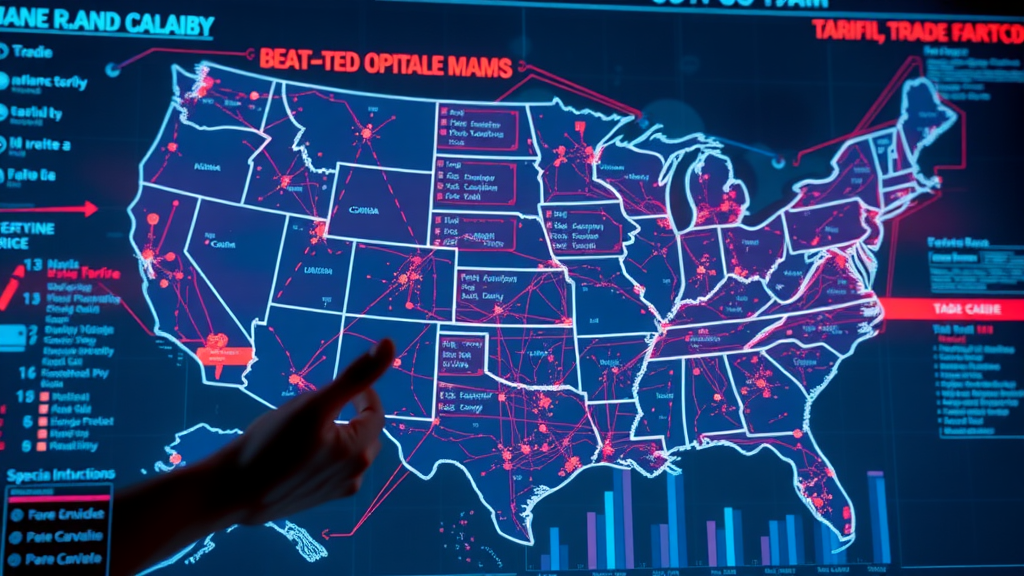Did you know? In 2023 alone, changes to the US tariff schedule affected more than $2.5 trillion worth of goods imported into the United States —a shift that has left importers, exporters, and businesses scrambling to adapt. Whether you’re a seasoned importer or just starting in international trade, understanding the evolving harmonized tariff schedule is crucial, not just to save money, but to avoid costly mistakes and penalties. This comprehensive guide delivers everything you need to know: from decoding recent updates to practical steps for correctly classifying your goods—no specialist jargon, just actionable insights.

Rising Costs or New Opportunities? The Evolving Impact of the US Tariff Schedule
The US tariff schedule is not just another regulatory document—it’s a powerful lever that can swing the fortunes of companies and reshape strategic decisions. For many businesses grappling with the impact of rising tariff rates , every update to the harmonized tariff schedule represents a potential risk—or an opportunity. Over the past year, major updates have targeted technology, consumer electronics, textile goods, and manufacturing components, with duty rates oscillating in response to policy shifts and international trade negotiations. The net result? Some industries have faced higher costs, while others have benefited from reduced duties or targeted exemptions.
Still, it’s not all about cost increases. Proactive organizations are leveraging the evolving tariff schedules to identify new sourcing partners abroad, take advantage of duty savings, and even unlock niche markets. Mastering the US tariff schedule thus means staying alert to both the regulatory risks and the emerging business opportunities, ensuring your company remains compliant and competitive in a dynamic global trade environment.
A Closer Look at Recent Changes in the Harmonized Tariff Schedule
Recent amendments to the harmonized tariff schedule reflect realities of shifting supply chains, updated product technologies, and mounting pressure from international trade agreements. For instance, product categories like semiconductors, lithium-ion batteries, and critical minerals underwent reclassification and rate adjustment, impacting both importers and exporters. The United States International Trade Commission publishes and maintains these changes, which have real implications for the classification of imports, customs clearance, and overall cost structure for companies relying on international trade .
Understanding these revisions isn’t just about compliance; it’s about opportunity. Businesses that quickly adapt to new tariff classifications can mitigate unexpected expenses, avoid shipment delays, and ensure favorable pricing in the import/export process. The harmonized tariff landscape will continue to evolve—so a keen eye on recent updates can be the difference between seizing market share and being left behind.
Understanding the US Tariff Schedule: Foundations for International Trade

What Is the US Tariff Schedule and Why Does It Matter?
At its core, the US tariff schedule (often called the Harmonized Tariff Schedule or HTS) is a structured legal handbook that determines the duty rate —the amount you pay—for products imported into the United States . It’s based on the internationally recognized Harmonized System (HS) Nomenclature developed by the World Customs Organization . This document serves as the federal government’s master reference for every tariff and category applied to imported goods—making it both a regulatory requirement and a critical tool for trade professionals.
Misunderstanding or misapplying the tariff rates in this schedule can be costly, leading to border delays, fines, and even legal action. On the other hand, correct usage ensures your goods move seamlessly through Customs and Border Protection (CBP) and that your company remains competitive in an ever-changing trade landscape. Whether you’re dealing with new-to-market products or staple imports, the US tariff schedule is your starting point for lawful, efficient, and cost-effective global commerce.
How the Harmonized Tariff Schedule Shapes Import and Export in the United States
The Harmonized Tariff Schedule influences every step of the import and export process. It forms the basis of tariff classification , supports trade statistics, and guides revenue collection for goods crossing US borders. Each item is assigned a 10-digit harmonized tariff code and a corresponding tariff rate , documented in the schedule of the United States —a document that is legally binding and essential in any international trade transaction.
Moreover, the structure and details in the US tariff schedule are regularly reviewed and updated to maintain alignment with international standards and domestic priorities. Major regulatory agencies—like the United States International Trade Commission and the CBP —collaborate to ensure the schedule remains up to date and accurate. Mastering these details isn’t optional: it’s a matter of compliance for any business seeking to import or export goods in (or from) the United States.
Mastering the Harmonized Tariff Schedule: Principles and Practical Uses
Reading and Interpreting Tariff Schedules: Key Sections and Codes
The US tariff schedule is structured for clarity but can appear overwhelming at first glance. It begins with broad product categories, each of which is broken down into chapters based on the Harmonized System . Within chapters, you find detailed headings, subheadings, and item numbers—culminating in unique 10-digit codes that identify your product and its precise duty rate .
To decode the harmonized tariff schedule , you’ll need to reference several key sections: General Rules of Interpretation (GRI), chapter notes, subheading notes, and the statistical annotations. Understanding how these sections interact is the key to proper tariff classification. Getting even a single digit wrong in the tariff code can lead to incorrect filings, higher duty payments, or regulatory issues with Customs and Border Protection .
The Role of the Harmonized Tariff in Ensuring Compliance
Compliance with the US tariff schedule extends beyond filling in paperwork—it requires strict adherence to the rules of the harmonized tariff schedule . Customs officials will review each declaration to ensure the selected code and associated tariff rate align with the actual goods presented. If discrepancies arise, shipments can be held, fines imposed, and companies investigated for potential fraud.
Practical compliance starts with understanding the complete classification and logic of the harmonized tariff schedule . Many organizations invest in training, utilize legitimate government resources, and consult with licensed customs brokers to mitigate risk and guarantee clarity in every shipment transaction. In the world of international trade, rigorous compliance is both a legal necessity and a competitive advantage.

Deciphering Tariff Rates: Strategies for Importers and Exporters
How Tariff Rates Are Set in the United States: The Schedule of the United States
In the United States , tariff rates are not static—they are set through a process involving both domestic legislation and international negotiation. The schedule of the United States outlines every rate, exemption, and quota governing goods moving in and out of the country. This document is jointly updated by the International Trade Commission and Customs and Border Protection , ensuring continual alignment with trade policy, economic development goals, and global customs practices.
When new legislation is enacted or when trade tensions rise, schedules are amended—sometimes increasing the duty rate on strategic goods, other times reducing tariffs to encourage particular imports. Successful importers and exporters track these changes, using the official harmonized tariff schedule as their reference, to accurately forecast costs and assess risks in their supply chain.
Current Tariff Schedules vs. Historical Tariff Rates in Global Trade
Comparing current tariff schedules to their historical counterparts sheds light on global trade dynamics and policy direction. Over the decades, the United States has used tariffs both as a tool of economic protection and as a bargaining chip in trade negotiations. Today’s average tariff rate is generally lower than it was in previous generations, but there remain notable exceptions—especially in politically sensitive industries like agriculture, steel, and electronics.
Staying informed about how the present harmonized tariff schedule mirrors or departs from past practice helps business leaders anticipate potential regulatory shocks and market access barriers. By monitoring historical trends, savvy companies adjust their procurement strategies and leverage tariff engineering where possible to minimize costs and maximize compliance.
Step-by-Step Guide: How to Use the US Tariff Schedule for Your Business
- Identifying Your Product’s Harmonized Tariff Code: Begin by carefully analyzing your product’s features and intended use, then use the online Harmonized Tariff Schedule or official government resources to pinpoint its correct code.
- Researching Changes in Tariff Schedules: Regularly monitor updates on the United States International Trade Commission (USITC) website or subscribe to bulletins to stay ahead of modifications affecting your goods.
- Applying the Correct Tariff Rate: Once you identify the appropriate code, verify the current tariff rate , check for any applicable Free Trade Agreements or special duty programs, and ensure all paperwork reflects the latest information.
- Ensuring Regulatory Compliance: Review all entries and declarations for accuracy. When in doubt, consult with a trade attorney, customs broker, or CBP guidance to minimize errors or penalties.
Recent Updates in the US Tariff Schedule: What to Watch for in 2024
| Product Category | 2023 Tariff Rate | 2024 Tariff Rate | Key Notes |
|---|---|---|---|
| Lithium-ion Batteries | 7.5% | 12.5% | Rate increase to support domestic manufacturing |
| Semiconductors | 5.6% | 6.8% | Reclassification of advanced chips |
| Textile Goods | 11% | 9% | Reduced duties on specific categories |
| Solar Panels | No special tariff | 14.6% | New tariffs for certain imports from Asia |
| Critical Minerals | 2.1% | 3.3% | Minor increase to foster local sourcing |
“The harmonized tariff schedule is not just a legal tool—it's a dynamic blueprint of America’s place in global commerce.”
Common Challenges and Best Practices When Navigating Tariff Schedules

- Avoiding Misclassification of Goods Under the Harmonized Tariff Schedule: Misclassification can result from misunderstanding product specifics or ignoring updates. Always double-check descriptions, request expert advice if needed, and document your rationale for code assignments.
- Keeping Up With Changing Tariff Rates: The harmonized tariff schedule is updated numerous times a year. Subscribing to official update feeds or using reputable third-party platforms helps ensure you’re using current rates in all filings.
- Using Reliable Tariff Schedule Resources for the United States: Depend on the USITC , CBP , and government-published guides rather than unverified online calculators. These official sources are updated promptly and recognized as legally binding in trade disputes.
What are the current tariffs in the US?
A comprehensive summary of major current tariffs, recent changes, and sector-specific highlights in the US tariff schedule.
The landscape of current tariffs in the United States is increasingly complex, with rates varying across hundreds of product categories. Major consumer items—like clothing, electronics, and vehicles—remain subject to variable tariff rates between 2% and 25%. Recent trade tensions saw heightened rates on goods from certain countries, including specialties like solar panels and critical technology components. Sectors such as textiles enjoy periodic reductions, while manufactured items and agricultural products may face surcharges or quotas, particularly during trade renegotiations or policy shifts under different administrations.

For the most accurate and up-to-date insight, always consult the latest official US tariff schedule , as the United States International Trade Commission and Customs and Border Protection frequently announce sector-specific adjustments. Key 2024 highlights include new duties on Asian-manufactured batteries, increased attention on rare earth imports, and eased tariffs for green energy items.
Which US department sets tariffs?
Explanation of key agencies: U.S. International Trade Commission, Customs and Border Protection, and their roles in the harmonized tariff schedule.
The authority to update, enforce, and interpret the US tariff schedule is divided among several key agencies. The United States International Trade Commission (USITC) is tasked with compiling, publishing, and updating the harmonized tariff schedule , aligning with both legislative directives and international agreements. The Customs and Border Protection (CBP), operating under the Department of Homeland Security , enforces compliance, checks tariff codes at ports of entry, and collects relevant duties.
Additionally, the U.S. Department of Commerce and other agencies regularly propose adjustments and negotiate international trade arrangements that impact current and future tariff schedules . Staying aware of agency announcements helps importers and exporters navigate evolving rules and prevent non-compliance issues before they arise.
What are the 4 types of tariffs?
Details on ad valorem, specific, compound, and tariff-rate quotas as seen in the US tariff schedule.
Within the harmonized tariff schedule , there are four fundamental types of tariffs applied in the United States :
- Ad Valorem Tariffs: Calculated as a percentage of the product’s declared value. For example, a 10% ad valorem duty rate on imported laptops.
- Specific Tariffs: Fixed-dollar amounts applied per unit, such as $1.50 per imported garment, regardless of its overall value.
- Compound Tariffs: A combination of ad valorem and specific, e.g., 5% of value plus $2 per item.
- Tariff-Rate Quotas: Allow a certain quantity at a lower tariff rate , with higher duties applied once the quota is exceeded—commonly used in agricultural goods.
Understanding which type of tariff applies to your goods is critical for correct cost estimations and customs declarations—and is a cornerstone of compliance in international trade.
How much were tariffs under Biden?
Analysis of tariff schedules under the Biden administration, with historical context and a focus on key policy changes.
Under the Biden administration, the harmonized tariff schedule saw targeted changes rather than sweeping increases or reductions. While core tariffs on steel and aluminum imports remained high—often exceeding 15%—the focus shifted toward leveraging tariffs as a tool for economic and environmental policy. Notable examples include the introduction of new duties on critical minerals and batteries, adjusting tariff classifications for green technologies, and periodic reviews aimed at easing or intensifying rates in response to global economic conditions.
Historical context reveals that overall tariff rates remained relatively stable, yet certain sectors experienced temporary surcharges to counteract dumping or subsidization by foreign producers. Staying updated with the schedule of the United States ensures that businesses don’t miss new exemptions and aren’t blindsided by sector-specific increases throughout the presidential term.
Watch this quick video to see how to search for, interpret, and apply the US tariff schedule to your unique business needs. We cover real-world examples, show where to find authoritative updates, and break down code identification—all in less than 5 minutes.
FAQs on the US Tariff Schedule and Harmonized Tariff System
-
How do I find the correct harmonized tariff code for my product?
Start by analyzing the composition and use of your product. Use the USITC’s online search tool to cross-reference HS codes and product descriptions, and review chapter notes in the harmonized tariff schedule . When classification is unclear, seek guidance from a customs broker or the CBP. -
Which resources offer the most up-to-date tariff schedules and rates?
The official United States International Trade Commission website is the definitive source. The CBP website and federal register notices also provide timely updates and legal interpretations. -
What are the penalties for incorrect tariff classification?
Misclassification can result in costly fines, customs delays, seizure of goods, and—in severe cases—federal investigation. Companies may also face back payments for underpaid duties. -
How frequently are U.S. tariff schedules updated?
The harmonized tariff schedule is updated several times per year to reflect changes from trade agreements, legislative actions, and international negotiations. Businesses should check for updates before every major shipment.
Key Insights and Takeaways for Navigating the US Tariff Schedule
- Stay informed about regular changes to the US tariff schedule
- Verify harmonized tariff codes rigorously
- Utilize official government resources for accurate information
- Consult with trade professionals when classification is unclear
Ready to share your expertise or insights on the US tariff schedule?
Got Something to Say About Global Trade? RP Design Web Services can put your insights on Global Trade Notes in front of the right audience. Call 203-271-7991 today and get your word out.
Conclusion: Actively monitor updates, validate your product classifications, and align with official US tariff resources to maximize compliance and minimize costly errors in your global trade operations.
The U.S. tariff schedule has recently undergone significant changes, particularly in 2025, affecting various industries and international trade relations. Notably, the United States and China have agreed to extend their tariff truce by 90 days, preventing a substantial escalation in duties that could have led to nearly a total embargo. This extension maintains current tariffs at 30% on Chinese goods and 10% on U.S. goods, allowing U.S. retailers to import goods for the Christmas season at lower rates. ( reuters.com )
Additionally, the European Union is awaiting further action from the United States to fulfill the terms of a framework trade agreement reached in late July. While the U.S. has implemented a 15% baseline tariff on European exports, other key provisions—such as a promised reduction of the 27.5% U.S. import tariff on EU automobiles and car parts to 15%—remain pending. ( reuters.com )
These developments underscore the dynamic nature of the U.S. tariff schedule and the importance of staying informed about ongoing trade negotiations and policy changes.
 Add Row
Add Row  Add
Add 




Write A Comment